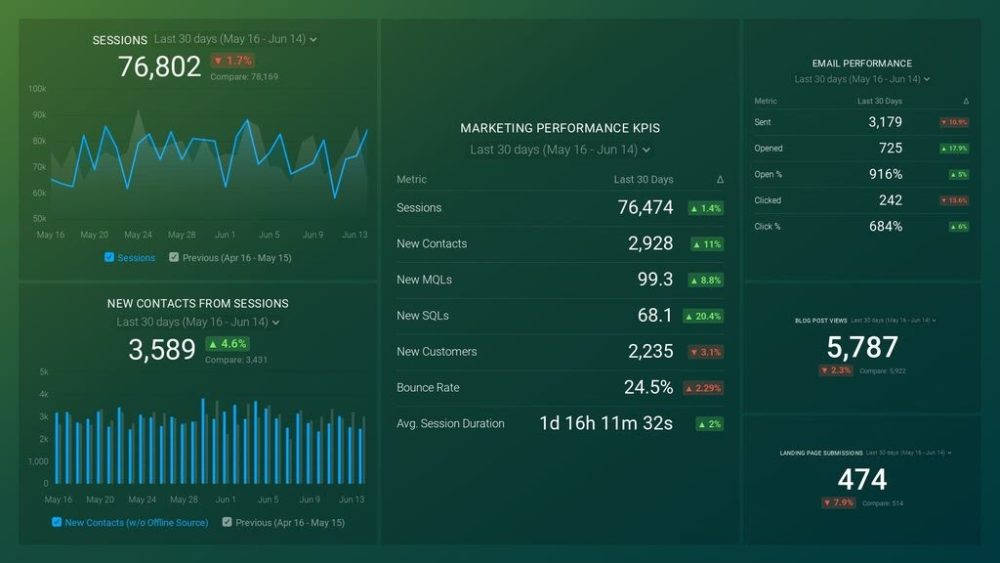 Data Analysis Reports in 9 Easy Steps" />
Data Analysis Reports in 9 Easy Steps" /> Data Analysis Reports in 9 Easy Steps" />
Data Analysis Reports in 9 Easy Steps" />
To see what Databox can do for you, including how it helps you track and visualize your performance data in real-time, check out our home page. Click here.
Imagine a bunch of bricks. They don’t have a purpose until you put them together into a house, do they?
In business intelligence, data is your building material, and a quality data analysis report is what you want to see as the result.
But if you’ve ever tried to use the collected data and assemble it into an insightful report, you know it’s not an easy job to do. Data is supposed to tell a story about your performance, but there’s a long way from unprocessed, raw data to a meaningful narrative that you can use to create an actionable plan for making steady progress towards your goals.
This article will help you improve the quality of your data analysis reports and build them effortlessly and fast. Let’s jump right in.

A data analysis report is a type of business report in which you present quantitative and qualitative data to evaluate your strategies and performance. Based on this data, you give recommendations for further steps and business decisions while using the data as evidence that backs up your evaluation.
Today, data analysis is one of the most important elements of business intelligence strategies as companies have realized the potential of having data-driven insights at hand to help them make data-driven decisions.
Just like you’ll look at your car’s dashboard if something’s wrong, you’ll pull your data to see what’s causing drops in website traffic, conversions, or sales – or any other business metric you may be following. This unprocessed data still doesn’t give you a diagnosis – it’s the first step towards a quality analysis. Once you’ve extracted and organized your data, it’s important to use graphs and charts to visualize it and make it easier to draw conclusions.
Once you add meaning to your data and create suggestions based on it, you have a data analysis report.
A vital detail everyone should know about data analysis reports is their accessibility for everyone in your team, and the ability to innovate. Your analysis report will contain your vital KPIs, so you can see where you’re reaching your targets and achieving goals, and where you need to speed up your activities or optimize your strategy. If you can uncover trends or patterns in your data, you can use it to innovate and stand out by offering even more valuable content, services, or products to your audience.
Data analysis is vital for companies for several reasons.
Trusting your intuition is fine, but relying on data is safer. When you can base your action plan on data that clearly shows that something is working or failing, you won’t only justify your decisions in front of the management, clients, or investors, but you’ll also be sure that you’ve taken appropriate steps to fix an issue or seize an important opportunity.
According to Databox’s State of Business Reporting, most companies stated that regular monitoring and reporting improved progress monitoring, increased team effectiveness, allowed them to identify trends more easily, and improved financial performance. Data analysis makes it easier to understand your business as a whole, and each aspect individually. You can see how different departments analyze their workflow and how each step impacts their results in the end, by following their KPIs over time. Then, you can easily conclude what your business needs to grow – to boost your sales strategy, optimize your finances, or up your SEO game, for example.
An additional way to understand your business better is to compare your most important metrics and KPIs against companies that are just like yours. With Databox Benchmarks, you will need only one spot to see how all of your teams stack up against your peers and competitors.
If you ever asked yourself:
Databox Benchmark Groups can finally help you answer these questions and discover how your company measures up against similar companies based on your KPIs.
When you join Benchmark Groups, you will:
When it comes to showing you how your performance compares to others, here is what it might look like for the metric Average Session Duration:

And here is an example of an open group you could join:

And this is just a fraction of what you’ll get. With Databox Benchmarks, you will need only one spot to see how all of your teams stack up — marketing, sales, customer service, product development, finance, and more.
Sounds like something you want to try out? Join a Databox Benchmark Group today!
Data doesn’t represent a magical creature reserved for data scientists only anymore. Now that you have streamlined and easy-to-follow data visualizations and tools that automatically show the latest figures, you can include everyone in the decision-making process as they’ll understand what means what in the charts and tables. The data may be complex, but it becomes easy to read when combined with proper illustrations. And when your teams gain such useful and accessible insight, they will feel motivated to act on it immediately.
Data analysis reports help teams collaborate better, as well. You can apply the SMART technique to your KPIs and goals, because your KPIs become assignable. When they’re easy to interpret for your whole team, you can assign each person with one or multiple KPIs that they’ll be in charge of. That means taking a lot off a team leader’s plate so they can focus more on making other improvements in the business. At the same time, removing inaccurate data from your day-to-day operations will improve friction between different departments, like marketing and sales, for instance.
You can also expect increased productivity, since you’ll be saving time you’d otherwise spend on waiting for specialists to translate data for other departments, etc. This means your internal procedures will also be on a top level.
Want to give value with your data analysis report? It’s critical to master the skill of writing a quality data analytics report. Want to know how to report on data efficiently? We’ll share our secret in the following section.
If you start writing without having a clear idea of what your data analysis report is going to include, it may get messy. Important insights may slip through your fingers, and you may stray away too far from the main topic. To avoid this, start the report by writing an outline first. Plan the structure and contents of each section first to make sure you’ve covered everything, and only then start crafting the report.
Don’t overwhelm the audience by including every single metric there is. You can discuss your whole dashboard in a meeting with your team, but if you’re creating data analytics reports or marketing reports for other departments or the executives, it’s best to focus on the most relevant KPIs that demonstrate the data important for the overall business performance.
Like most marketers and marketing managers, you want to know how well your efforts are translating into results each month. How much traffic and new contact conversions do you get? How many new contacts do you get from organic sessions? How are your email campaigns performing? How well are your landing pages converting? You might have to scramble to put all of this together in a single report, but now you can have it all at your fingertips in a single Databox dashboard.
Our Marketing Overview Dashboard includes data from Google Analytics 4 and HubSpot Marketing with key performance metrics like:
Now you can benefit from the experience of our Google Analytics and HubSpot Marketing experts, who have put together a plug-and-play Databox template that contains all the essential metrics for monitoring your leads. It’s simple to implement and start using as a standalone dashboard or in marketing reports, and best of all, it’s free!

You can easily set it up in just a few clicks – no coding required.
To set up the dashboard, follow these 3 simple steps:
Step 1: Get the template
Step 2: Connect your HubSpot and Google Analytics 4 accounts with Databox.
Step 3: Watch your dashboard populate in seconds.